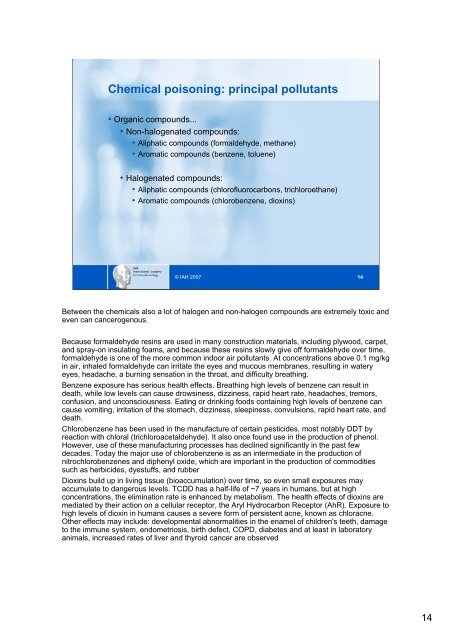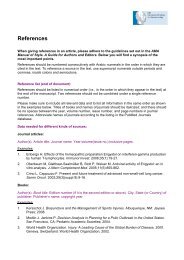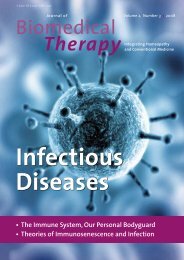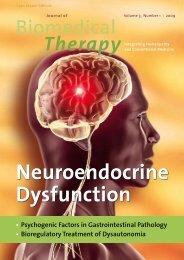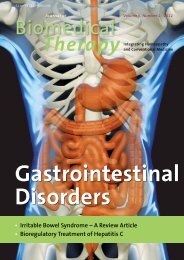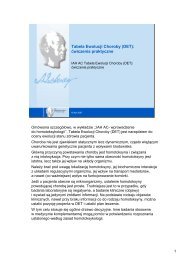Types of Homotoxins
Types of Homotoxins
Types of Homotoxins
You also want an ePaper? Increase the reach of your titles
YUMPU automatically turns print PDFs into web optimized ePapers that Google loves.
Chemical poisoning: principal pollutants<br />
• Organic compounds...<br />
• Non-halogenated compounds:<br />
• Aliphatic compounds (formaldehyde, methane)<br />
• Aromatic compounds (benzene, toluene)<br />
• Halogenated compounds:<br />
• Aliphatic compounds (chlor<strong>of</strong>luorocarbons, trichloroethane)<br />
• Aromatic compounds (chlorobenzene, dioxins)<br />
© IAH 2007<br />
14<br />
Between the chemicals also a lot <strong>of</strong> halogen and non-halogen compounds are extremely toxic and<br />
even can cancerogenous.<br />
Because formaldehyde resins are used in many construction materials, including plywood, carpet,<br />
and spray-on insulating foams, and because these resins slowly give <strong>of</strong>f formaldehyde over time,<br />
formaldehyde is one <strong>of</strong> the more common indoor air pollutants. At concentrations above 0.1 mg/kg<br />
in air, inhaled formaldehyde can irritate the eyes and mucous membranes, resulting in watery<br />
eyes, headache, a burning sensation in the throat, and difficulty breathing.<br />
Benzene exposure has serious health effects. Breathing high levels <strong>of</strong> benzene can result in<br />
death, while low levels can cause drowsiness, dizziness, rapid heart rate, headaches, tremors,<br />
confusion, and unconsciousness. Eating or drinking foods containing high levels <strong>of</strong> benzene can<br />
cause vomiting, irritation <strong>of</strong> the stomach, dizziness, sleepiness, convulsions, rapid heart rate, and<br />
death.<br />
Chlorobenzene has been used in the manufacture <strong>of</strong> certain pesticides, most notably DDT by<br />
reaction with chloral (trichloroacetaldehyde). It also once found use in the production <strong>of</strong> phenol.<br />
However, use <strong>of</strong> these manufacturing processes has declined significantly in the past few<br />
decades. Today the major use <strong>of</strong> chlorobenzene is as an intermediate in the production <strong>of</strong><br />
nitrochlorobenzenes and diphenyl oxide, which are important in the production <strong>of</strong> commodities<br />
such as herbicides, dyestuffs, and rubber<br />
Dioxins build up in living tissue (bioaccumulation) over time, so even small exposures may<br />
accumulate to dangerous levels. TCDD has a half-life <strong>of</strong> ~7 years in humans, but at high<br />
concentrations, the elimination rate is enhanced by metabolism. The health effects <strong>of</strong> dioxins are<br />
mediated by their action on a cellular receptor, the Aryl Hydrocarbon Receptor (AhR). Exposure to<br />
high levels <strong>of</strong> dioxin in humans causes a severe form <strong>of</strong> persistent acne, known as chloracne.<br />
Other effects may include: developmental abnormalities in the enamel <strong>of</strong> children's teeth, damage<br />
to the immune system, endometriosis, birth defect, COPD, diabetes and at least in laboratory<br />
animals, increased rates <strong>of</strong> liver and thyroid cancer are observed<br />
14


